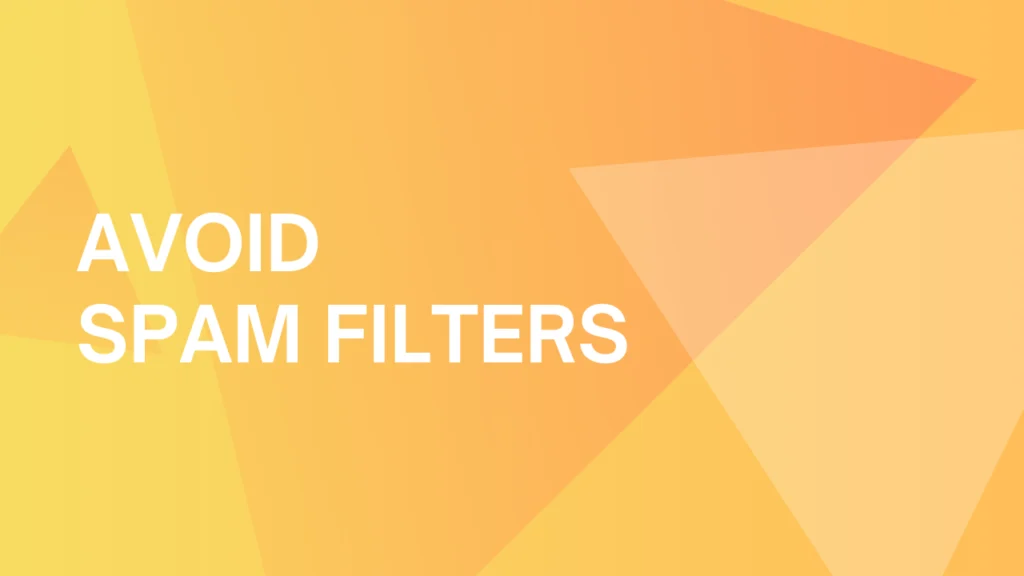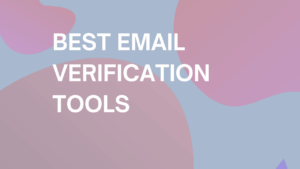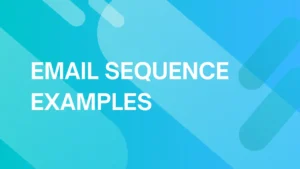
How to Avoid Spam Filters? (24 Proven Tips)
Avoiding spam filters will help your emails land in inboxes, not the spam folder. With the right strategies, you can significantly improve the success of your email campaigns and maintain steady inbox placement.
This article provides practical tips to help marketers improve their email deliverability and avoid common spam triggers. You’ll learn:
- Proven methods for maintaining long-term deliverability and minimizing the risk of emails being flagged as spam
- The key factors spam filters look for and how to steer clear of them
- Strategies to improve your email reputation, including proper domain authentication and writing effective email content
What is a spam filter?
A spam filter is a program based on various complex algorithms and AI technology that is trying to distinguish valid emails and messages from malicious, unsolicited, or unwanted ones.
The purpose of the spam filters is to protect users and their email inboxes from spammers by analyzing incoming emails and determining whether the messages are valid or are potential spam that should be filtered out.
Spam emails and messages are a common problem for almost every email user – there are over 300 billion spam emails sent out to users on a daily basis.
Due to this fact, spam filters play an important role in the user’s protection as well as improve their UX by filtering out annoying or potentially dangerous emails.
How do spam filters work?
Spam filters use a variety of criteria to decide if an incoming email should be flagged as spam.
After scanning each message, the filter assigns a spam score, which determines if the email should pass through or remain in the filter.
Scores vary between servers. There are several different categories of mail filters.
- Content filters look for suspicious words inside an email or subject line.
- Bayesian filters rely on the user’s specified spam preferences to learn and adapt over time.
- Rule-based filters allow for certain types of messages to filter through based on user-prescribed rules.
- Permission filters require the sender to be pre-approved by the recipient.
- Challenge-response filters ask the sender to enter a code that grants permission to send the message.
- Blacklist filters stop any message from coming through that was sent from a known spam sender.
Mail filtering solutions can be deployed in various ways, from a hosted or “cloud” solution to an on-premise device or an installed software program that integrates with the user’s email client.
Generally speaking, spam filters take into account many signals when analyzing and evaluating incoming emails such as:
- The reputation of the sender’s IP
- The content of the subject line
- The content of the email (e.g. spammy words or phrases)
- The number of links, images, or other rich media in the email
- The user’s interaction with the email (e.g. replying to the email, deleting it, marking it as “spam”, etc.)
It is important to understand that any email campaign and its success can be influenced by these signals – if your emails will appear as “spammy” or potentially harmful, spam filters will simply prevent those emails from reaching the user’s main inbox.
Fortunately, there are several ways you can improve and optimize your emails and avoid spam filters altogether.
How to avoid spam filters (best practices)
1. Choose a reliable ESP
Choosing a good and reliable Email Service Provider (ESP) is a first step to ensure that you will pass spam filters with your email campaigns.
The reason is pretty straightforward – a good and trustworthy ESP always makes sure that its users are protected from anyone who wants to spam them.
Therefore ESPs like Gmail, Hotmail, Yahoo!, etc., are always a good option since they pay attention to the quality of emails and email addresses and try to build a good reputation by protecting (but also checking) their clients and their activities.
2. Authenticate your domain
Domain authentication indicates to spam filters that you are a verified and legitimate user and the emails are actually sent on your behalf (and not by some spammer).
Authenticating your email makes you more trustworthy (since spammers usually do not bother with Domain Authentication) and increases the chance that your email campaigns won’t be filtered out by spam filters.
The process of authenticating your domain consists of 3 main records:
- SPF (Send Policy Framework) – prevents spammers from sending emails via your domain
- DKIM (Domain Key Identified Mail) – prevents email spoofing by anyone who has malicious intent
- DMARC (Domain-based Message Authentication, Reporting & Conformance) – secures a proper authentication of SPF and DKIM of the email address
3. Avoid dynamic IP address
A dynamic IP address can be considered as a red flag to spam filters – since there can be more people who can send emails (and potentially spam recipients) from the same IP.
If you are using a dynamic IP address for email marketing, you are not in control over your IP’s reputation – there is a higher risk that somebody may use your IP for spamming purposes which can result in perceiving your emails as spam as well.
Therefore, it is recommended to switch to a dedicated IP address instead – an IP address for your email account that can be used and controlled solely by you and no one else.
4. Obtain third-party accreditation
Third-party accreditation verifies the user as a trustworthy email sender and allows him to send various emails without the risk of being stopped by spam filters.
Third-party companies that provide this “certification of trust” have established strong relationships with Internet Service Providers (ISPs) and guarantee that a given email sender can be listed as a trusted user.
In order to obtain a third-party accreditation, you need to prove that you are a legitimate sender (and not some spammer) as well as pay a fee for the service.
5. Check your IP address reputation
The reputation of the IP address is a strong factor in email deliverability.
If you are sending emails from a new IP address or the one with a really bad reputation (e.g. due to previous spamming history), ESP may stop delivering your emails before they could be even evaluated by spam filters.
Therefore, it is strongly recommended to regularly check your IP address reputation and use tools like Warmup Inbox to improve and keep the “health” of your domain over time.
There are many ways that you can use this tool for the process of improving your reputation such as:
- Sending and receiving automatic emails
- Automatically pulling up emails from the spam folder
- Checking public email blacklists
- Tracking the “health” of your domain
6. Write the recipient’s name in the “To:” field
Filling up the “To:” field in your email indicates to spam filters that you actually know who the recipient is and therefore your email is tailored especially for him.
Furthermore, including the recipient’s name personalizes your email – the user can be more inclined to open and actually read your message which are both positive engagement signals in the eyes of the spam filters.
Therefore, always make sure that you know who you are writing to and include their names in the “To:” field of your email.
7. Use a familiar name in the “From” line
Including your name in the “From” line will increase the chance that the recipient will open and read your message – and therefore indicate to the ESP that you are a reliable sender that should not end up in the spam folder.
Generally speaking, people tend to open emails more from senders that they are familiar with – as opposed to generic company or brand names that do not sound very personal.
Due to this fact, you can always include your name in the “From” line and limit the risk that the recipients will see you as potential spam.
8. Avoid “trigger” words
Emails that contain spammy words like “free”, “guarantee” or even “best price” might be considered as malicious or unwanted messages that should end up in the spam folder.
Spam filters always check the incoming emails and evaluate their content based on the words and phrases they contain – if there are suspicious phrases that a spammer would use, they will be automatically blocked.
An example of a specific error message related to spammy content is “550 high probability of spam,” which indicates that the server has flagged the email content as likely spam.
Therefore, try to avoid any click-bait titles, headlines, or false claims that would sound “spammy” or misleading in the eyes of the recipient as well as for the spam filters.
Here is a shortlist of common words and phrases that can be considered as “trigger” words:

Tip: If you would like to know more about words and/or phrases that should not be used in your emails, check out this ultimate list of trigger words made by HubSpot.
9. Don’t include attachments
Attachments in the email (e.g. PDFs, Word documents, etc.) are a huge red flag for the spam filters – since any attached files may contain malicious data or viruses.
Besides the risk of being blocked by spam filters, attachments may significantly increase the size of your email which can result in a longer loading time (and therefore a bad user experience).
Instead of the attachment, you should provide a link or call-to-action button in the body of your email that will lead the user to the actual document’s location.
10. Don’t use too many pictures
Emails that contain too many or too large images might be evaluated as potential spam in the eyes of the spam filters.
Many people assume that using images in their emails might improve the recipient’s engagement – the problem is that spam filters don’t really “see” what is in the pictures and may assume that they contain unwanted or harmful content.
Furthermore, images in the emails tend to significantly increase the loading time which can impact the user experience in the inbox and reduce the deliverability rate.
In order to avoid these problems, try to use images to a minimum and always compress their sizes for a better UX.
11. Add alt text to the images
Speaking of images – many users won’t allow displaying images in their received emails which can make your emails look “spammy” and provide a terrible user experience.
By adding alt texts to the images, recipients that block images by default can still know what the pictures in the email might be about and therefore understand the message you are trying to tell them.
Alt-text is especially useful if you provide call-to-action buttons or links in the form of images – readers can still understand the intent behind the image even when it is not displayed properly:
Here are a few tips on how to properly write alt texts for your images
- Keep it concise but descriptive – try to describe what is in the picture just in a few words
- Avoid ambiguous descriptions – don’t write just some general or abstract alt texts that would not tell the reader anything about the content of the image
- Don’t write misleading alt text – avoid any false descriptions that would deceive the readers
12. Avoid rich media
Rich media (e.g. embedded videos, Flash, JavaScript, etc.) can cause many technical problems when implemented to the content of the email.
Generally speaking, any rich media content is not recommended to use within any emails – many email clients won’t allow you to display any type of content besides the text or simple images.
Furthermore, content such as videos or dynamic scripts may result in a messy or broken message that would look spammy and result in a terrible UX.
Instead of including rich media content directly to your email, try to provide a link or CTA button that will lead the reader to the destination with your rich media.
13. Keep your emails short
Spam filters pay attention to the length of your emails – if they are too long, they might be considered as potential spam that is generated by some bot (and not by an actual human being).
In addition, long email copies tend to be ignored more by the recipients – people like to read short emails that are on point rather than long essays that would take minutes to read.
Therefore, if you want to avoid spam filters and keep the reader’s attention, try to write concise emails with various breaking elements (e.g. paragraphs, bullet points, etc.)
14. Limit the number of links
Emails that contain too many links tend to be considered as a “potential risk” and therefore filtered out by spam filters.
There are 2 main reasons why you should limit the number of links within your emails:
- It looks less spammy and suspicious – many spammers tend to spread a large number of malicious links across the email’s content (which will automatically trigger the spam filters)
- It navigates readers to your destination – by including only the most important links (e.g. CTA button), users can quickly understand where they should click on – which is a primary goal of your email campaign.
15. Avoid all caps and exclamation points
Email titles or sentences written in all caps or containing exclamation points tend to be perceived as annoying, spammy as well as impolite to the recipients.
According to the Radicati Group, over 85% of email recipients tend to prefer subject lines of incoming emails written in lowercase – which can dramatically influence the open rate of any email they obtain.
Furthermore, cold email subject lines that are written in all-caps or contain too many exclamation points usually look suspicious and therefore are reported as spam more often.
Because of that, you should always write subject lines, titles, or even actual content without any all-caps words and limit the number of exclamation points to a minimum.
16. Don’t use different font colors
Colorful fonts, as well as irregular font sizes, may trigger spam filters and prevent your emails from being delivered to the recipient’s primary inbox.
Many spammers use invisible/white text or various font colors and sizes in their email messages in order to trick the readers and make them accidentally click on some link.
In addition, using different colors and sizes for your email text causes terrible UX – people tend to like uniform font sizes since they are easier to read and look more trustworthy.
17. Check your grammar
Emails that contain too many spelling mistakes or grammatical errors are perceived as very unprofessional and may alert spam filters.
Although small mistakes are not considered as a huge red flag, readers may take your emails less seriously if they have faulty grammar.
To avoid your emails from looking “spammy”, always make sure that the email content is grammatically correct and does not contain any spelling errors.
18. Use double opt-in
Double opt-in is a subscription method that requires the email recipient to click on a confirmation link in a follow-up email when subscribing to your email list.
The double opt-in method provides 2 main benefits:
- It brings valuable users – people who subscribe to you by this method actually want to receive and read your emails in the future
- It helps to avoid spam filters – by opening and subscribing to you via follow-up email, the email user clearly indicates that he wishes to read messages from your email address (and therefore it should not end up in the spam folder)
19. Include an unsubscribe link
You should always include an unsubscribe link in every email that you send to your subscribers.
Unsubscribe link is a standard practice that gives the recipients an option to stop receiving your emails – for whatever reasons they want to.
Although an unsubscribe link does not provide a direct benefit to you, it is a necessary element that helps you clear out your email list – otherwise, you would be actually “spamming” people that don’t want to obtain emails from you anymore.
Due to this fact, it is recommended to provide a simple unsubscribe link or button in the footer of your emails that can be visible and easily reached by the recipients.

20. Offer HTML and a plain-text version
Emails containing both HTML and plain-text versions of the content provide options for the recipients to choose how they want to read your emails.
People have various preferences when it comes to reading their messages – some of them like visual elements in the email content, some of them prefer simple text formatting that is user-friendly.
By providing both types of formatting, readers, as well as ISPs, may consider your emails as legitimate and reduce the chance of being reported as unwanted spam.
21. Don’t buy email lists
You should never buy and use email lists for any of your email marketing campaigns – emails from these lists usually do not provide any value and increase the chance that your email account will be reported (and blocked) as spam.
Generally speaking, email lists from third parties contain a lot of inactive accounts or simply have a list of people that are not interested in your emails at all.
Sending unwanted emails to those people can be considered a huge red flag to the spam filters as well as to the ESPs and ISPs – since you would be actually “spamming” emails that nobody asked for.
22. Clean your email lists regularly
Email lists that are not regularly updated may over time start to consolidate inactive subscribers, expired email addresses, or just uninterested users who will not open any of your emails at all.
This can cause various problems such as:
- Higher spamming reports – users who are not interested in your emails anymore might start reporting you as spam which can significantly harm your account in the future
- Higher bounce rate – if your email list contains a lot of expired addresses, Internet Service Providers may stop sending your emails to other active accounts
Therefore, you should always update and “clean” your email lists from all the addresses that do not provide any value or simply are not active anymore.
23. Test your emails
You should always test your emails before sending them to the email recipients.
There are many useful tools that can help you test and evaluate the quality of your email content and check whether or not it will be blocked by spam filters.
You can use our free email spam checker to quickly evaluate the spam score of your email as well as its inbox placement.
This will help you to see if or where your email will land before sending it to your subscribers or potential new leads.
24. Stay up-to-date with email sending laws
Always make sure that you are following the law and have a clear overview of any legal changes that can happen over time.
Most of the countries have already enforced some laws against spam (e.g. GDPR, CAN-SPAM ACT, etc.) – therefore make sure that you are not in violation of any of them.
| Tip: If you are preparing a wide-scale email campaign, you can book a 30-minute free consultation. |



